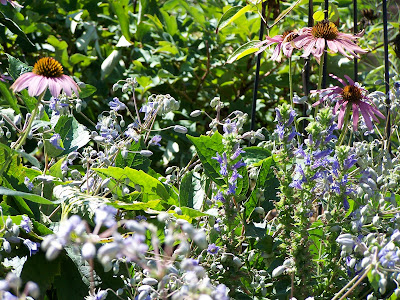 One of my favorite parts of my garden these days is in the front, near my neighbor's, Darryl Kelley, driveway. A huge specimen of exotic (remember, "exotic" here means "not native"!) Clematis heraclifolia 'Mrs. Robert Brydon' grows there, partly through an obelisk, spilling over right to the edge of the driveway and the sidewalk. Nearby are clumps of Echinacea purpurea (Purple Coneflower - also exotic, as it's native only to the southwestern corner of Michigan) and Lobelia syphilitica (Great Blue Lobelia). I love how the Clematis spills through the Coneflower and Lobelia, knitting the diverse plants together into a beautiful tapestry. I think it also helps that the texture and form of the Clematis and Echinacea leaves are very similar, so the various flowers really get to strut their stuff, from the clusters of tiny blue Clematis to the taller spikes of Blue Lobelia, punctuated by the pink daisy-like flowers of the Coneflower. This is an excellent example of exotic and native plants can be successfully combined in any garden.
One of my favorite parts of my garden these days is in the front, near my neighbor's, Darryl Kelley, driveway. A huge specimen of exotic (remember, "exotic" here means "not native"!) Clematis heraclifolia 'Mrs. Robert Brydon' grows there, partly through an obelisk, spilling over right to the edge of the driveway and the sidewalk. Nearby are clumps of Echinacea purpurea (Purple Coneflower - also exotic, as it's native only to the southwestern corner of Michigan) and Lobelia syphilitica (Great Blue Lobelia). I love how the Clematis spills through the Coneflower and Lobelia, knitting the diverse plants together into a beautiful tapestry. I think it also helps that the texture and form of the Clematis and Echinacea leaves are very similar, so the various flowers really get to strut their stuff, from the clusters of tiny blue Clematis to the taller spikes of Blue Lobelia, punctuated by the pink daisy-like flowers of the Coneflower. This is an excellent example of exotic and native plants can be successfully combined in any garden.The best of the action is definitely going on in the back yard, though. Just one vignette consists of all natives, a small section of which I was able to capture in another image this morning. I think it's pretty interesting, as the season declines, that Mother Nature seems to dress herself in the purple of Asters (various species, now that they've decided our Asters are not actually Asters, although the plants still belong to the Asteracea family) and Ironweed (Vernonia spp.) and the yellow of Cup Plant (Silphium perfoliatum) and Rosinweed (S. integrifolium) and the Goldenrods (Solidago spp.) that are still coming along. Pretty neat that these colors are complements on the color wheel, intensifying one another when in close juxtaposition. Here it's Rosinweed and Ironweed (neither of which, in my opinion, are weedy at all!) topped by the delicate white flower spires of wandering of Wild Cucumber (Echinocystis lobata) - another neat combination.
I'm also liking some of the smaller stuff in the back, including Wild Petunia (Ruellia humilis) combined with some sort of exotic sedum and the foliage of Japanese Roof Iris (Iris tectorum alba). The contrast in foliage texture and color is just great here, as the petite spires of the Wild Petunia rise above the sprawling sedum and the iris foliage (not as glaucus as German Iris (I. germanica)) contrasts in texture and color. You can see the first of the Downy Sunflowers (Helianthus mollis) just to the back, adding its cheerful yellow to a composition otherwise dominated by cooler tones.

I had some avian visitors today - not the Baltimore Oriole (Icterus galbula) I saw a couple days ago but the Ruby-Throated Hummingbird (Archilochus colubris) was here this afternoon (the first I've seen it this season, although I'm sure it's been here before - and will hopefully return!) and a beautiful brilliantly-yellow male Gold Finch (Carduelis tristis - I wonder why it's "sad"?) was having a great time in the flowers of the Cut-leaf Coneflower (Rudbeckia laciniata). I did get a photo of him (left) but it's pretty tough to capture a yellow bird in the middle of a bunch of yellow flowers in a bit of a breeze; I did my best!
I hope you can join us tomorrow to share in some of the wonders of my garden during this season! Garden Tour is 10a-2p - hope to see you!






No comments:
Post a Comment